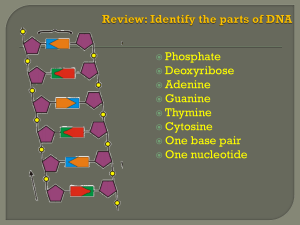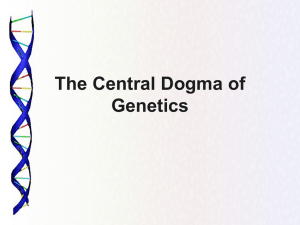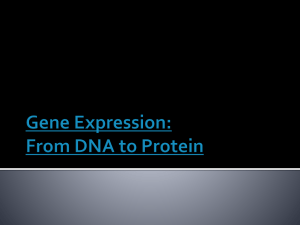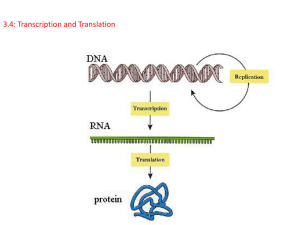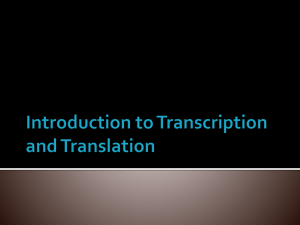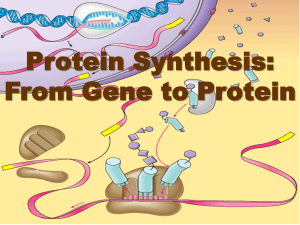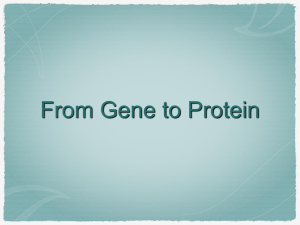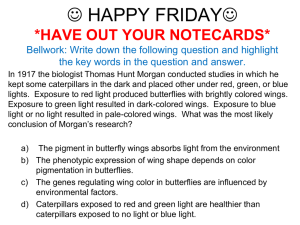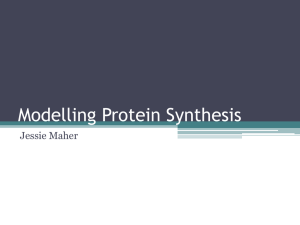Chapter 17 - Madeira City Schools
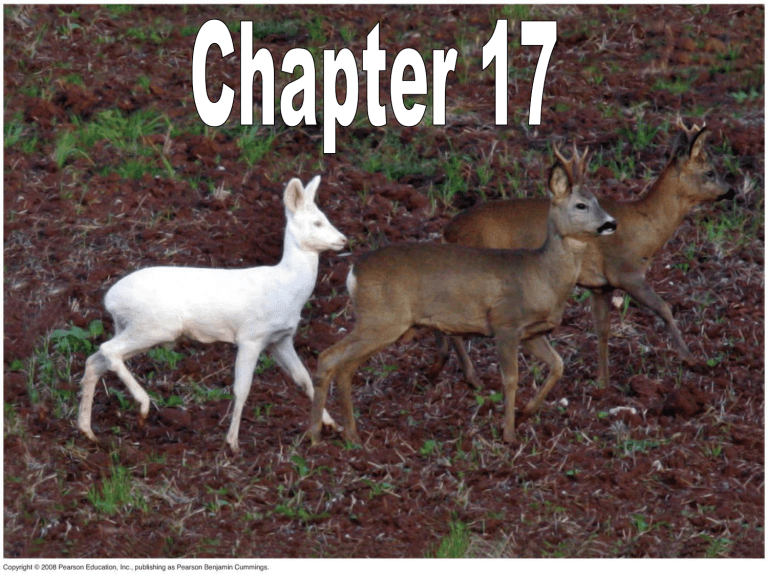
I. The connection between genes and proteins
A. Garrod, British physician - 1909
1. Hypothesis:
2. Studied Alkaptonuria a. urine appears black because it contains alkapton b. people with disease lack enzyme to break down alkapton
B. George Beadle and Edward Tatum 1930’s
1. Searched for mutants of bread mold -- differed in the nutrient needs
2. What he did: (next slide)
3. Formulated the one gene-one enzyme hypothesis
4. Further research lead to: one gene – one protein one gene – one polypeptide one gene – many closely related polypeptides or RNA molecule.
Mutants required arginine in their growth medium.
Nonmutants could make their own arginine. Found 3 classes of mutants, each defective in one gene.
Grew 3 classes of mutants under 4 conditions
Ornithine and citrulline are intermediate molecules in the arginine production pathway.
Each class of mutant was unable to carry out one step to synthesize arginine because it lacked an enzyme.
Results supported the one gene one enzyme hypothesis and showed the arginine production pathway.
C. Protein Synthesis: An overview
1. DNA ---> RNA ---> Protein (or RNA that is used to control other things)
2. Transcription =
4. Translation =
5. Prokaryotic versus Eukaryotic
Prok: DNA ---> mRNA ---> Ribosome ---> Protein
Euk: DNA ---> pre-mRNA ---> mRNA ---> Ribosome ---> Protein
D. Flow of information from gene to protein is based on a triplet code
1. For each gene, only one of the two DNA strands is transcribed a. the “template strand” b. strand varies throughout DNA
2. Read pg. 328—331 for further detail on triplet code.
II. The Synthesis and
Processing of RNA
A. Transcription
1. RNA Polymerase II binds to DNA and initiates transcription a. Promoter = is typically 25 nucleotides upstream from the starting point.
This is where the TATA box (nucleotide sequence containing TATAAAA on the nontemplate strand) is.
The promoter determines where RNA polymerase II starts and which strand to use.
Transcription factors (collection of proteins) mediate the binding of RNA polymerase II forming the “transcription initiation complex”
2. Sequence of Initiation a. Transcription factors (one recognizing the TATA box) bind to DNA before RNA polymerase II can b. RNA polyerase II and additional transcription factors bind forming the Transcription
Initiation Complex” c. DNA helix unwinds and RNA synthesis begins at starting point
3. Elongation of the RNA strand a. RNA Polymerase II can only add to the 3’ end b. several molecules of RNA polymerase II follow each other c. follows base pairing rules.
d. 40 nucleotides per second
4. Termination of transcription a. differs between eukaryotic and prokaryotic
Prokaryotic:
RNA polymerase transcribes a “terminator” sequence which functions as the termination signal. Polymerase detaches from DNA and releases the transcript. It is immediately available for translation.
Eukaryotic:
RNA polymerase II transcribes a sequence on the DNA called the “polyadenylation signal sequence” (AAUAAA)
10 – 35 nucleotides downstream pre-mRNA is released.
B. Pre-mRNA processing to mRNA: alter ends and splice genes
1. Enzymes in the nucleus modify the pre-mRNA
2. Alteration of mRNA ends a. 5’ end is capped off (“ 5’cap ”) b. an enzyme adds a “ poly (A) tail ” to the 3’ end
3. RNA Splicing (cut and paste) a. “Split Genes” = there are noncoding sequences interspersed between coding segments of the gene.
b. Introns = c. Exons = d. signal to splice is a short nucleotide sequence at the end of an intron.
e. “small nuclear ribonucleoproteins” (aka…snRNPs) recognize site.
f. snRNPs join with others and proteins to make a
“spliceosome” (almost the size of a ribosome).
4. Why do we have introns?
a. introns may play regulatory role in the cell—contain sequences that control gene activity in some way. Splicing process may regulate passage of mRNA from nucleus to cytoplasm.
b. many genes give rise to 2 or more different proteins depending on which segments are treated as exons during processing.
c. introns may play role in variation of genes d. About 60% of genes are estimated to have alternative splicing sites.
e. One gene does not equal one polypeptide
III. The synthesis of protein = Translation
A. Key players
1. tRNA (transfer RNA) a. made in the nucleus and reused in the cytoplasm b. one end is a triplet anticodon, the other is a specific amino acid c. 45 different tRNA’s (some anticodons can recognize 2 or more different codons) d. Wobble = e. modified base inosine (I) f. "Wobble" effect allows for 45 types of tRNA instead of 61.
Reason - in the third position, U can pair with A or G.
Inosine (I), a modified base in the third position can pair with
U, C, or A.
2. Aminoacyl-tRNA Synthetase a. joins the correct amino acid to the tRNA b. 20 of these, the active site fits only a specific combination of amino acid and tRNA. (ATP needed)
3. Ribosomes a. 2 subunits (large and small) b. made of proteins and rRNA c. P site (peptidyl-tRNA site) – holds tRNA that has polypeptide chain d. A site (aminoacyl-tRNA site) – holds tRNA carrying next amino acid e. E site (exit site) – where tRNA leaves the ribosome
Large subunit
(Has P, A, and E sites)
Proteins rRNA
Both subunits
B. Building a Polypeptide
1. Initiation a. small subunit attaches to the “leader” segment of the mRNA at the 5’ end (5’ cap tells small subunit to attach) b. initiator tRNA (carrying the amino acid methionine) attaches to the initiation codon (AUG) at the P site c. large subunit attaches d. proteins (“initiation factors”) do this and GTP is used for nrg
2. Elongation -- 3 step cycle a. protein (elongation factor) ushers tRNA to A site
(GTP used) b. rRNA of large subunit catalyzes peptide bond formation c. mRNA moves translocating all the tRNA’s over one site
This requires energy (GTP )
3. Termination a. stop codon in the A site is reached (UAA, UAG, UGA) b. protein (“release factor”) binds to stop codon in the A site c. the release factor causes a water molecule to bond to polypeptide chain instead of an amino acid d. this reaction hydrolyzes the polypeptide from the tRNA that is in the P site (releasing it)
C. Additional Information
1. Polyribosomes – a string of ribosomes along the same strand of mRNA.
a. allows a single strand of mRNA to produce many copies of a polypeptide
2. Posttranslational modifications – additional steps required before a protein can begin doing job a. amino acids chemically modified (sugars, lipids, phosphate groups may be added) b. enzymes may remove methionine from leading part of strand.
c. chain may be cleaved into 2 or more pieces (insulin) d. polypeptides may join one another (quaternary structure )
Polyribosomes
Prokaryotes
3. Free vs. Attached Ribosomes a. can switch as needed b. Protein synthesis always begins in the cytosol when a free ribosome starts to translate an mRNA molecule.
c. this process continues to completion UNLESS the growing polypeptide cues the ribosome to attach to the
ER.
d. the above polypeptides have a signal peptide (a sequence of 20 amino acids at or near the leading
(amino) end of the polypeptide.
e. signal is recognized by a signal recognition particle
(SRP) as the 20 amino acids emerge from the ribosome.
f. The SRP brings the ribosome to a receptor protein in the ER membrane, where synthesis continues.
C. Mutations =
1. Point Mutation a. Base-pair substitutions = missense mutations nonsense mutations b. Insertions and deletions =
2. Mutagens =
3. Mutations can be harmful and useful

